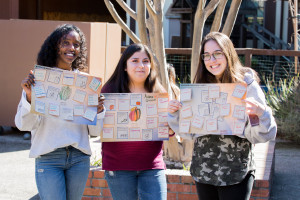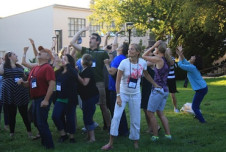Social-emotional learning (SEL) teaches the key attitudes and skills necessary for understanding and managing emotions, listening, feeling and showing empathy for others, and making thoughtful, responsible decisions. For five years, I was an educator in the field teaching mindfulness and emotional skills to teenagers at six different high schools.
 Students work on Project Wayfinder activities.
Students work on Project Wayfinder activities.
Over and over, I saw the power of mindfulness to transform the inner lives of students. Students became less stressed, more self-regulated, and more thoughtful toward their classmates. But I also saw that students did not understand how to connect these new skills and experiences to build purpose-driven projects in their real lives. There was a gap between the inner development and the real-world implementation.
That is where purpose-based education comes in. Purpose, as defined by Bill Damon of Stanford University, is “something that is meaningful to the self, and consequential to the world.” This new movement of purpose-based learning organizations is connecting the principles and practices of SEL to what students do in the world and to the question, “What do I do with my life?” It’s developing the connective tissue between internal skills and external projects, future plans, and big life decisions.
Over the past five years, half a dozen organizations have popped up around the country focused on developing purpose among high school students, including the Future Project, the QUESTions Project, NxU, Noble Impact, and Project Wayfinder (the organization I founded). This new movement in education can have a lasting impact, as long as it evolves in the right direction.
Here are a few suggestions—based on discussions with educators and leaders of purpose-based organizations—for educators seeking to develop more meaning and purpose in the lives of their students, and for those who want to take SEL and mindfulness to the next level.
1. Make it applicable to real life
 Project Wayfinder's Purpose Compass
Project Wayfinder's Purpose Compass
Students need to feel and understand that mindfulness and SEL skills will actually be applicable outside the classroom, to things that happen in their real lives—in areas like applying to college, thinking about their future, getting a summer job, or dealing with family matters at home.
For example, imagine a teenager is working on a project they really care about and a big piece of it falls through unexpectedly. Then, a teacher gives them a lesson on dealing with adversity and different strategies to bounce back from it. The student does the lesson with a real-life example in mind and then can apply it more readily.
The Purpose Compass, an activity we developed at Project Wayfinder, asks students to find the intersection of three components: what they love to do, a need in the world, and a skill they have or want to develop. This connects a student’s self-awareness (knowing what they love to do) with external life skills, thus bridging the gap between the internal and external. Through this activity, a number of real-life student projects have been born, like a student-designed T-shirt company to support social justice causes.
2. Integrate SEL classes throughout school
One way to show how SEL lessons apply to real life is to connect them to other subjects in school. Research shows that for SEL programs to succeed in high schools, the biggest school-wide shift they need to make is to become well-integrated into other subject matters—rather than being a standalone “feelings class” (as one of my students called it) awkwardly sandwiched between chemistry and AP history.
There are creative ways to integrate purpose learning throughout classes. At Project Wayfinder, we’ve found that our curriculum fits best in advisory, a kind of homeroom-plus that many high schools have once or twice a week that focuses on personal development, life skills, and connecting with teachers.
Schools have found a number of other ways to integrate our curriculum—for example, in a combined math/English seminar or a project-based science class. One teacher in Hawaii used our tools and exercises to kick off his “Finding Poetry” course. Students are guided to do inner discovery work, which then jumpstarts the creative process for poetry.
If you want to integrate SEL or purpose learning, first take an inventory of your existing lessons and look for implicit social, emotional, and moral components. SEL and purpose skills could also be helpful in the learning process itself—as students try to persevere, work together, and stay motivated.
3. Bring student voices into the curricula
Students live in a digital world where there are literally millions of well-designed things available in the palm of their hand. This makes design even more crucial for engaging students, especially in a non-required or non-graded course. Curricula need to be more than well-designed; they must be varied, fun, and multimedia. They must feel different from your average class.
How do you design a lesson that’s fun for students? The best way to do this is to ask them what would be engaging and then test it. For example, the QUESTions project took three years to develop its curriculum with student input the whole way.
For teachers in the classroom, you can work with students to decide on ground rules for their lessons. Instead of having rules imposed on them, they can be involved in decisions about the layout of the classroom, how you use the class period together, and how much they are teaching each other or leading the class.
We rarely ask students to participate like this or give feedback on a curriculum, and even less often change the curriculum based on their feedback. At Project Wayfinder, we tested every piece of the curriculum multiple times with a variety of student groups and are making substantial changes next year based on their feedback. This way, the content becomes even better and more targeted over time.
4. Cultural competency
Research shows that students of color in particular do not take SEL lessons home. Being mindful of cultural differences and building more culturally responsive curricula will help SEL lessons be relevant to more students.
In U.S. K-12 education, students of color make up half the student body, but 80 percent of teachers are white. At Project Wayfinder, we place a heavy emphasis on recruiting diverse guides to help co-create our curriculum with different student populations in mind, as do many of the other purpose development organizations. The Future Project, for example, places “Dream Directors“ directly into schools, the majority of whom are people of color. These Dream Directors play the role of mentor and coach—working with students on purposeful projects and personal development, while simultaneously trying to build a supportive school culture.
Since developing a sense of purpose is so tied to one’s identity, it is crucial to have teachers, mentors, and guides that young people identify with in their purpose journey. It’s also crucial to be more attuned to cultural differences in values and emotional expression. Rather than assuming that all students have a homogenous experience with concepts like gratitude or conflict resolution, for example, we can invite discussion about these differences.
5. The role of the teacher
For SEL and purpose-based curricula to be effective, teachers need to be able to embody what they are teaching—to be self-aware, emotionally intelligent, and deeply connected with their own sense of purpose.
“Establishing a culture of psychological safety in the classroom starts with the teacher,” says J. Eric Wilson, CEO of Arkansas-based Noble Impact. “You’re asking students to take a risk by opening up in front of their peers. Establishing trust between the teacher and students is a prerequisite for everything we do.”
For example, teachers must be willing to be vulnerable with students. They must act more like a coach or mentor as opposed to a content-delivery agent.
A simple exercise is simply to spend time explaining why you are a teacher. Why do you choose to teach every day and care about your students? In a Project Wayfinder activity called The Journey Track, teachers share their own personal life journey to teaching. Many teachers have said this helps students connect with them more deeply and see them more as a whole person, not just a teacher.
6. Teacher training
For SEL and purpose development programs, teacher training and development is arguably the most important piece of the puzzle. At Project Wayfinder, we require that every teacher who uses our curriculum is trained by us, either at one of our summer institutes or at an on-site training. We have found that teachers who do not get trained by us feel less confident and struggle more in teaching our curriculum. The training is more than a how-to—it is a deep dive into their own sense of purpose and how best to relate to their students.
One of the things we and other organizations are continuing to explore is what kind of ongoing and increased support teachers need as they continue down the path of purpose education. For example, Mindful Schools developed a specific year-long certification program to help train cohorts of teachers to continue to develop their skills.
For teachers that come from underfunded schools, many of these programs (including ours) offer scholarships, and there are an increasing number of online tools for teachers to use for professional development.
Teachers and educators are thirsty for an answer to students’ feelings of boredom and the need for hoop jumping. They want something fresh, relevant, challenging, and inspiring for their students. Purpose education has the potential to fill that role—and to move students into the 21st century with the skills, mindsets, and practices they need to thrive in an increasingly unpredictable world.








Comments